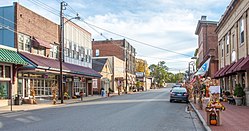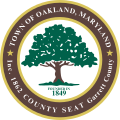2010 census
As of the census [12] of 2010, there were 1,925 persons, 875 households, and 470 families living in the town. The population density was 743.2 inhabitants per square mile (287.0/km2). There were 1,009 housing units at an average density of 389.6 per square mile (150.4/km2). The racial makeup of the town was 98.0% White, 0.2% African American, 0.3% Native American, 0.6% Asian, 0.1% from other races, and 0.9% from two or more races. Hispanic or Latino of any race were 0.7% of the population.
There were 875 households, of which 23.1% had children under the age of 18 living with them, 40.1% were married couples living together, 10.5% had a female householder with no husband present, 3.1% had a male householder with no wife present, and 46.3% were non-families. 40.5% of all households were made up of individuals, and 16.6% had someone living alone who was 65 years of age or older. The average household size was 2.03, and the average family size was 2.73. and 24; 22.6% were from 25 to 44; 30.2% were from 45 to 64; and 22.5% were 65 years of age or older. The gender makeup of the town was 47.7% male and 52.3% female.
2000 census
As of the census of 2000, [12] there were 1,930 persons, 787 households, and 447 families living in the town. The population density was 915.7 inhabitants per square mile (353.6/km2). There were 918 housing units at an average density of 435.5 per square mile (168.1/km2). The racial makeup of the town was 98.13% White, 0.73% African American, 0.16% Native American, 0.57% Asian, 0.16% from other races, and 0.26% from two or more races. Hispanic or Latino of any race were 0.78% of the population. 33% of Oakland's residents were of German descent, 11% English, 11% Irish, 6% Italian, 2% Dutch, 2% French, 2% Polish, 2% Scottish, 2% Scotch-Irish and 2% Swedish. People of Swiss, British, Welsh and Hungarian descent each comprised 1% of the population. [13]
There were 787 households, out of which 25.3% had children under the age of 18 living with them, 43.6% were married couples living together, 9.8% had a female householder with no husband present, and 43.1% were non-families. 38.8% of all households were made up of individuals, and 18.7% had someone living alone who was 65 years of age or older. The average household size was 2.09, and the average family size was 2.75.
In the town, the population was spread out, with 18.5% under the age of 18, 9.4% from 18 to 24, 24.0% from 25 to 44, 23.2% from 45 to 64, and 24.9% who were 65 years of age or older. The median age was 43 years. For every 100 females, there were 85.8 males. For every 100 females age 18 and over, there were 84.2 males.
The median income for a household in the town was $26,728, and the median income for a family was $38,750. Males had a median income of $29,625 versus $21,542 for females. The per capita income for the town was $16,872. About 13.3% of families and 19.0% of the population were below the poverty line, including 21.9% of those under age 18 and 21.0% of those age 65 or over.










